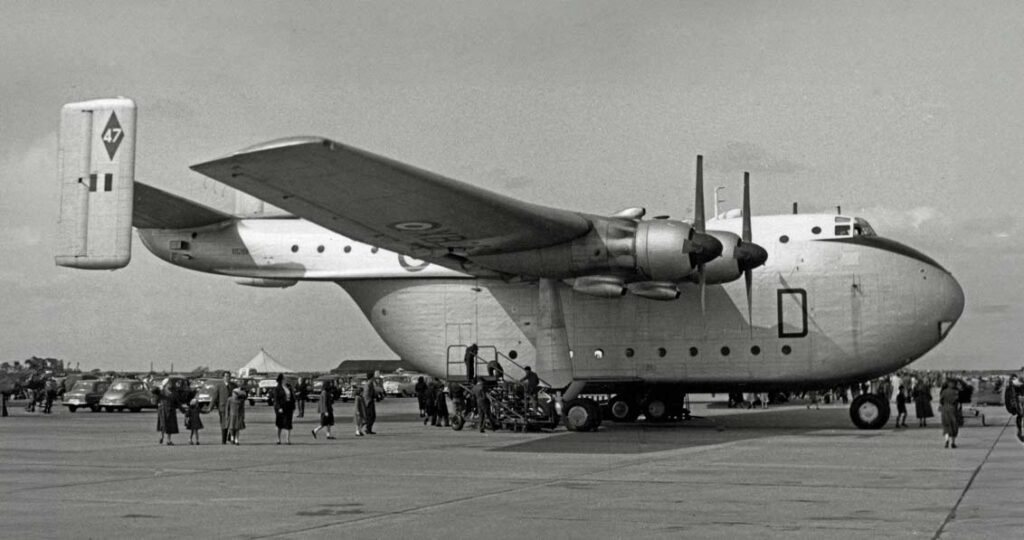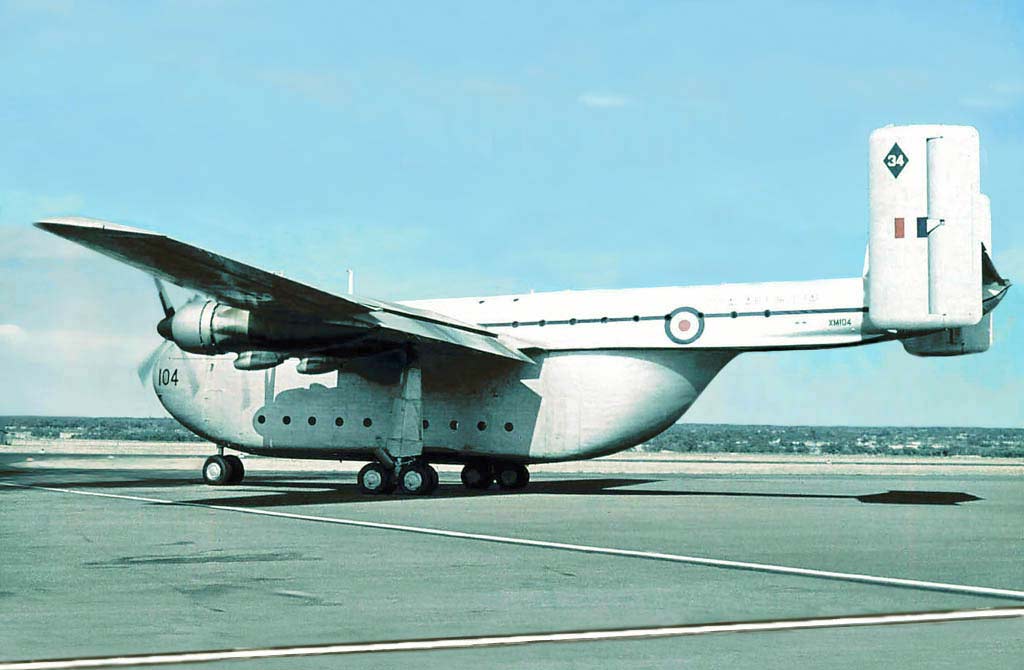The Blackburn Beverley was a British heavy-lift transport aircraft, known for its large payload capacity and ability to operate from rough airstrips.
In brief
The Blackburn Beverley was a British heavy transport aircraft, first flown in 1950 and introduced into service in 1955. It was designed for carrying large and bulky payloads and was capable of operating from rough or imperfect runways. The Beverley featured a high-wing cantilever monoplane design with a fixed undercarriage and was powered by four Bristol Centaurus 173 18-cylinder radial piston engines. It was primarily used by the Royal Air Force for military transport tasks, including troop and cargo transport, and had a distinctive appearance due to its high tail boom and large, bulbous fuselage. The Beverley remained in service until 1967 and was known for its robustness and versatility.
The Blackburn Beverley was an important aircraft in the history of British military aviation, particularly noted for its significant cargo capacity and ability to operate from less developed airfields.

History of the Development of the Blackburn Beverley
The Blackburn Beverley’s development began in the aftermath of World War II, during a period when there was a clear need for improved military transport capabilities. The aircraft was designed by General Aircraft as the GAL.60 Universal Freighter. The first prototype, disassembled at the factory in Feltham, Middlesex, was transferred to Brough, Yorkshire, and took its first flight on June 20, 1950. The second prototype, known as the Gal.65, featured several changes from the initial design.
The Royal Air Force placed an initial order for 20 aircraft on October 1, 1952, designating it as the Beverley C.1 (Beverley, Cargo Mark 1). The name Beverley was officially given to the aircraft in December 1952. Production was accelerated with several subassemblies being manufactured at the works in Dumbarton. Further orders increased the total to 47 aircraft, all constructed at Blackburn’s Brough facility. The first production Beverley performed a rocket-assisted takeoff (RATOG) during short takeoff trials in December 1956.
The Beverley saw various trials, including tropical trials in North Africa in the summer of 1955, and winter trials in Canada during late 1955 and early 1956. The last Beverley was completed in 1958, with no other customers secured outside the RAF. There were efforts to market the Beverley in the civil sector, including as a cross-Channel car ferry and for civil freighter operators in the Middle East, but these did not materialize.
Design of the Blackburn Beverley
The Blackburn Beverley was designed as a large transport aircraft capable of carrying heavy and bulky payloads and landing on rough or imperfect runways. It was a high-wing cantilever monoplane with a fixed undercarriage. The engines and accessories were installed in interchangeable bays on the lower surface of the wing. The twin-spar wings comprised two separate sections bolted onto the fuselage. The design focused on simplicity and maintainability, thus lacking pneumatics or cabin pressurization. The fuselage was divided into four main sections with an exterior surface primarily composed of riveted Alclad plating. It featured large low-pressure Dunlop tires fitted to the single-wheel undercarriage.
Performance of the Blackburn Beverley
The Beverley was powered by four Bristol Centaurus 173 engines, each producing a maximum takeoff thrust of 2,850 horsepower. It had a maximum speed of 207 knots and a recommended cruise speed of 150 knots. The travel range was 1,100 nautical miles at 8,000 feet with 13,000 kg of payload and 140 nautical miles with 23,000 kg of payload. The ferry range was 3,440 nautical miles at 3,600 kg. It could fly up to 16,000 feet and climb at a rate of 760 feet per minute. The aircraft had an external length of 30.30 meters, a height of 11.80 meters, and a wingspan of 49.40 meters. The empty weight was 35,950 kilograms, with a maximum takeoff weight of 61,235 kilograms.
Variants of the Blackburn Beverley
The Blackburn Beverley had several variants. The GAL.60 Universal Freighter Mk I was the initial prototype with door-and-ramp loading and Bristol Hercules engines. The GAL.65 Universal Freighter Mk II (B-100) was a subsequent prototype with a clamshell-style cargo door and passenger seating in the tail boom section. The Beverley C.Mk 1 (B-101) was the definitive production mark. Two attempts to evolve the basic Mk 1 production model, the B-107 and B-107A, were made but did not progress to working prototypes.

Military Use and Combat of the Blackburn Beverley
The Blackburn Beverley was used extensively by the Royal Air Force for military transport tasks. It did not have armament, as its mission loadout was typically cargo in nature, including supplies, infantry, paratroops, etc. The Beverley was involved in various operations, supporting British actions and interests in places like Bahrain, Kenya, and the Far East. It participated in operations such as Operation Fortitude in Jordan in 1958. The Beverley remained in service until 1967, when it was replaced by the Hawker Siddeley “Andover.” Of the 49 aircraft completed, nine were lost to accidents.
The Blackburn Beverley was a distinctive and important aircraft in the history of British military aviation. Its significant cargo capacity and ability to operate from less developed airfields made it a valuable asset for the Royal Air Force. Although its service life was relatively short, the Beverley’s robustness, versatility, and unique design left a lasting impact on military transport aviation.
Back to Transport planes.